Data Representation and Digital Logic Assignment 1
VerifiedAdded on 2024/04/25
|12
|1641
|293
AI Summary
This assignment covers topics like one's complement, two's complement, signed magnitude, unsigned magnitude, binary, octal, decimal, hexadecimal, Boolean functions, and circuit diagrams.
Contribute Materials
Your contribution can guide someone’s learning journey. Share your
documents today.
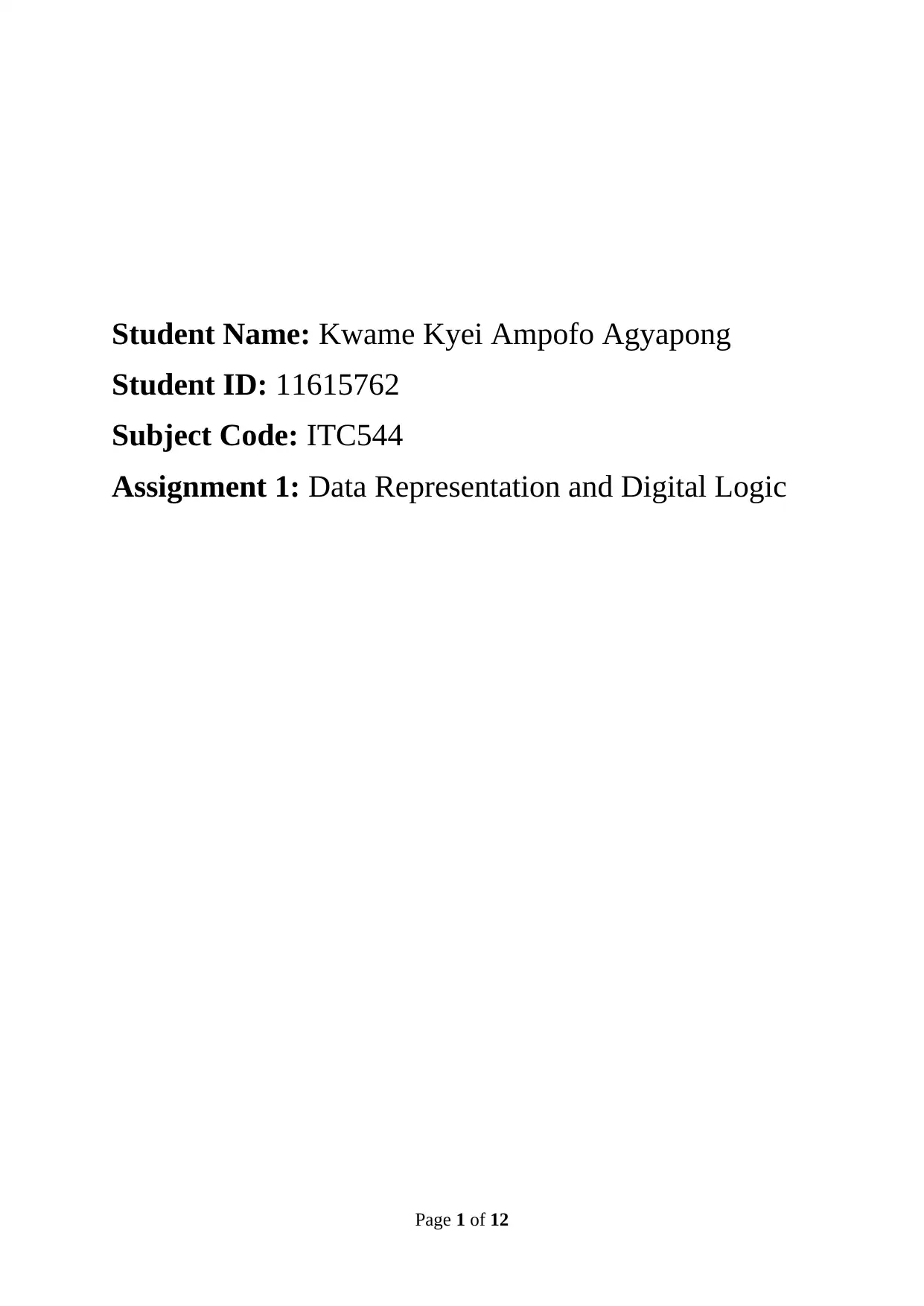
Student Name: Kwame Kyei Ampofo Agyapong
Student ID: 11615762
Subject Code: ITC544
Assignment 1: Data Representation and Digital Logic
Page 1 of 12
Student ID: 11615762
Subject Code: ITC544
Assignment 1: Data Representation and Digital Logic
Page 1 of 12
Secure Best Marks with AI Grader
Need help grading? Try our AI Grader for instant feedback on your assignments.
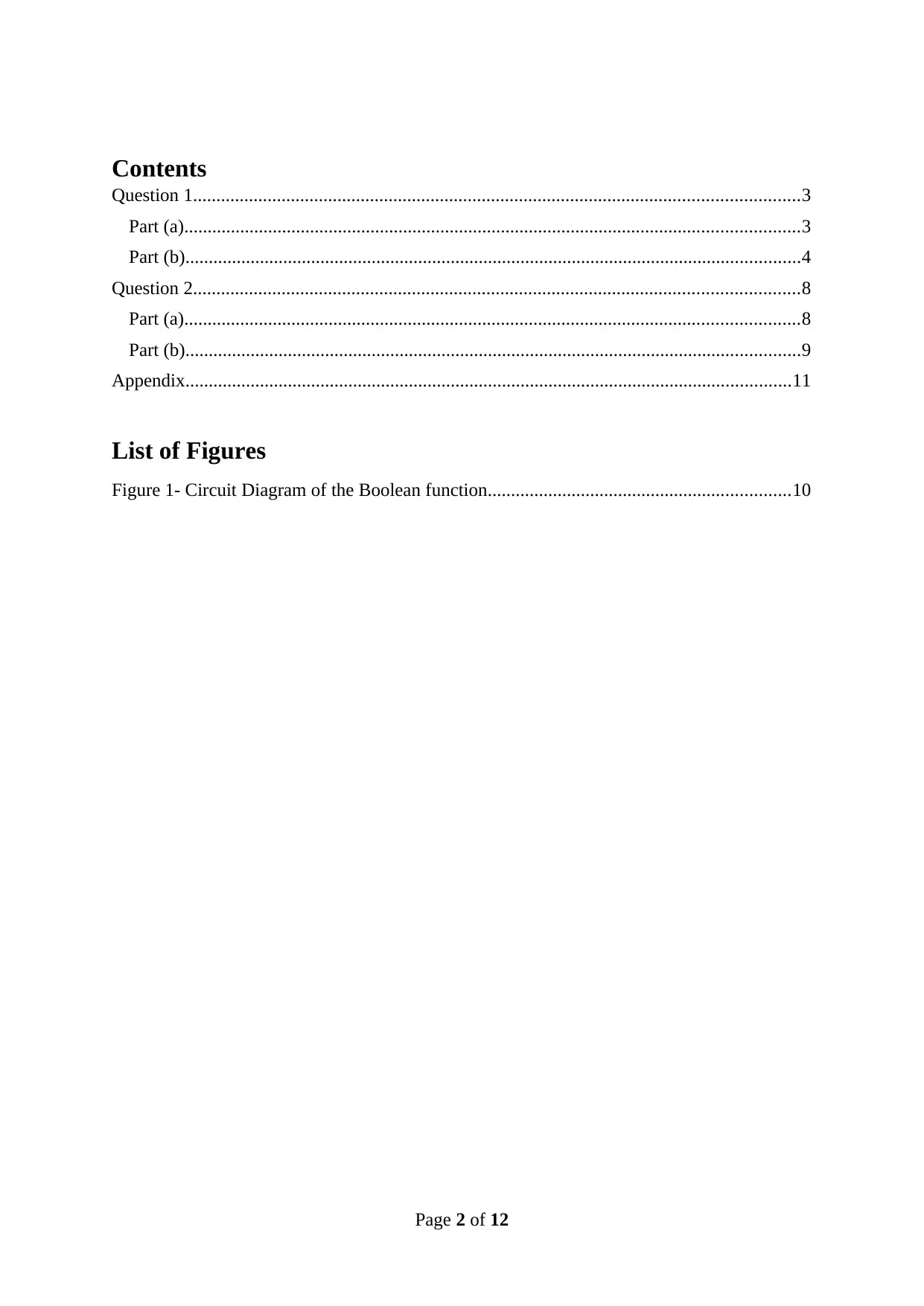
Contents
Question 1..................................................................................................................................3
Part (a)....................................................................................................................................3
Part (b)....................................................................................................................................4
Question 2..................................................................................................................................8
Part (a)....................................................................................................................................8
Part (b)....................................................................................................................................9
Appendix..................................................................................................................................11
List of Figures
Figure 1- Circuit Diagram of the Boolean function.................................................................10
Page 2 of 12
Question 1..................................................................................................................................3
Part (a)....................................................................................................................................3
Part (b)....................................................................................................................................4
Question 2..................................................................................................................................8
Part (a)....................................................................................................................................8
Part (b)....................................................................................................................................9
Appendix..................................................................................................................................11
List of Figures
Figure 1- Circuit Diagram of the Boolean function.................................................................10
Page 2 of 12
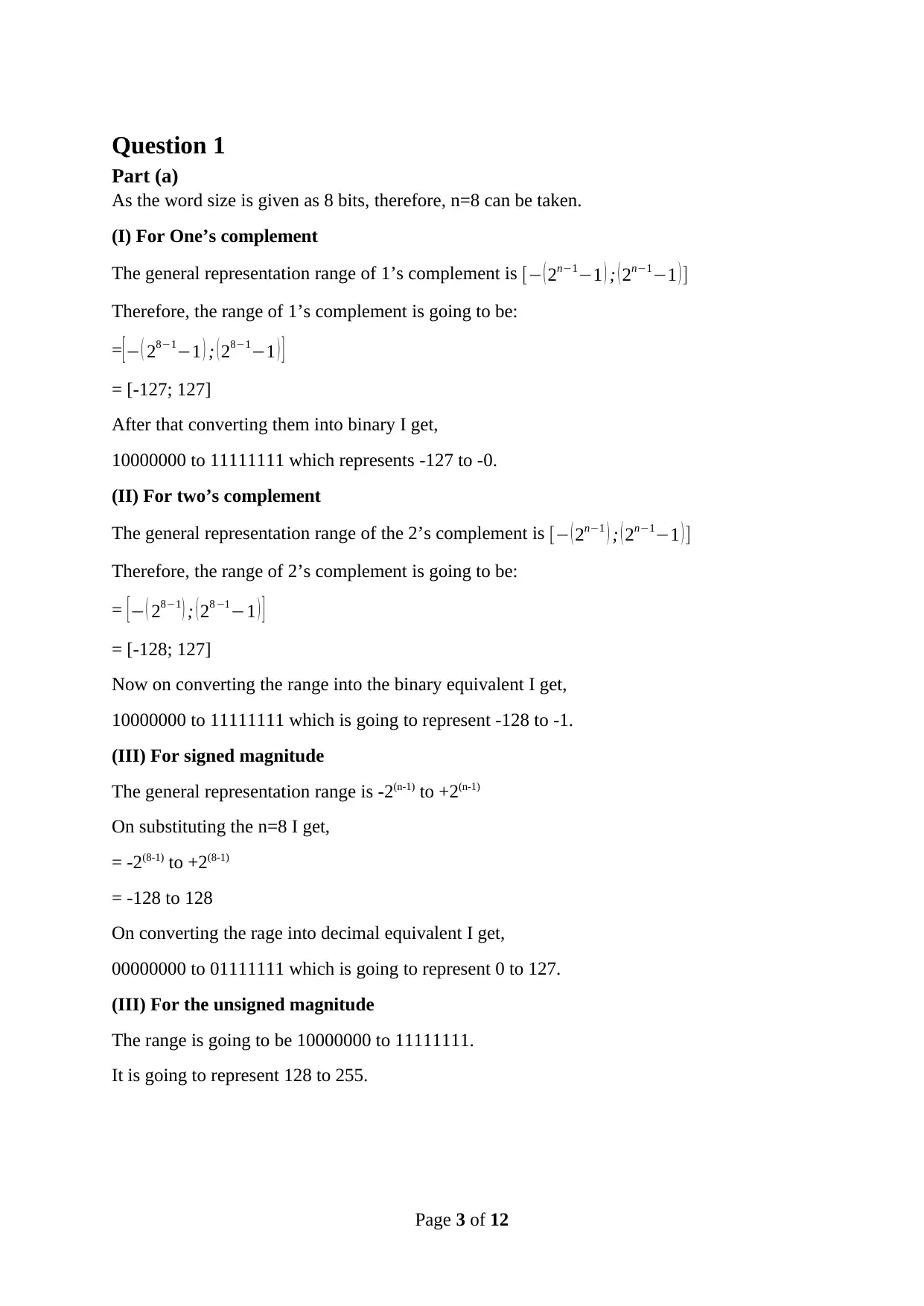
Question 1
Part (a)
As the word size is given as 8 bits, therefore, n=8 can be taken.
(I) For One’s complement
The general representation range of 1’s complement is [− ( 2n−1−1 ) ; ( 2n−1−1 ) ]
Therefore, the range of 1’s complement is going to be:
=[ − ( 28−1−1 ) ; ( 28−1−1 ) ]
= [-127; 127]
After that converting them into binary I get,
10000000 to 11111111 which represents -127 to -0.
(II) For two’s complement
The general representation range of the 2’s complement is [− ( 2n−1 ) ; ( 2n−1−1 ) ]
Therefore, the range of 2’s complement is going to be:
= [− ( 28−1 ) ; ( 28 −1−1 ) ]
= [-128; 127]
Now on converting the range into the binary equivalent I get,
10000000 to 11111111 which is going to represent -128 to -1.
(III) For signed magnitude
The general representation range is -2(n-1) to +2(n-1)
On substituting the n=8 I get,
= -2(8-1) to +2(8-1)
= -128 to 128
On converting the rage into decimal equivalent I get,
00000000 to 01111111 which is going to represent 0 to 127.
(III) For the unsigned magnitude
The range is going to be 10000000 to 11111111.
It is going to represent 128 to 255.
Page 3 of 12
Part (a)
As the word size is given as 8 bits, therefore, n=8 can be taken.
(I) For One’s complement
The general representation range of 1’s complement is [− ( 2n−1−1 ) ; ( 2n−1−1 ) ]
Therefore, the range of 1’s complement is going to be:
=[ − ( 28−1−1 ) ; ( 28−1−1 ) ]
= [-127; 127]
After that converting them into binary I get,
10000000 to 11111111 which represents -127 to -0.
(II) For two’s complement
The general representation range of the 2’s complement is [− ( 2n−1 ) ; ( 2n−1−1 ) ]
Therefore, the range of 2’s complement is going to be:
= [− ( 28−1 ) ; ( 28 −1−1 ) ]
= [-128; 127]
Now on converting the range into the binary equivalent I get,
10000000 to 11111111 which is going to represent -128 to -1.
(III) For signed magnitude
The general representation range is -2(n-1) to +2(n-1)
On substituting the n=8 I get,
= -2(8-1) to +2(8-1)
= -128 to 128
On converting the rage into decimal equivalent I get,
00000000 to 01111111 which is going to represent 0 to 127.
(III) For the unsigned magnitude
The range is going to be 10000000 to 11111111.
It is going to represent 128 to 255.
Page 3 of 12

Part (b)
I. 0x5AB into Octal
As 0x represents the Hexadecimal number. So the conversion of the hexadecimal to the octal
number is going to be as follow:
Firstly, I am going to convert the hexadecimal number to the decimal equivalent. For that
certain equation is required which is shown below:
= 5*162 +10*161 +11*160
=1280+160+11
= (1451)10
Now to convert into the octal certain procedures has to be followed which is shown below:
8 1451
8 181 3
8 22 5
2 6
So the octal number is (2653)8 or it can be represented as 0o2653.
II. 101101.1012 into Decimal
For that I have to follow certain steps which is shown below:
=1*25+ 0*24+ 1*22+ 0*21+ 1*20
= 32 + 0 + 8 + 4 + 0 + 1
= 45
Now, for decimal part i.e. 101,
I have done certain calculation which is shown below:
= 1*2-1 + 0*2-2 +1*2-3
= 0.5 + 0 + 0.125
= 0.625
On combining both part, solution is going to be:
= (45.625)10
III. 12348 into Binary
To perform this conversion, I have to convert this into decimal. For that certain steps have to
be followed which are shown below:
= 1*83+ 2*82+ 3*81+ 4*80
= 512+ 128 + 24 + 4
Page 4 of 12
I. 0x5AB into Octal
As 0x represents the Hexadecimal number. So the conversion of the hexadecimal to the octal
number is going to be as follow:
Firstly, I am going to convert the hexadecimal number to the decimal equivalent. For that
certain equation is required which is shown below:
= 5*162 +10*161 +11*160
=1280+160+11
= (1451)10
Now to convert into the octal certain procedures has to be followed which is shown below:
8 1451
8 181 3
8 22 5
2 6
So the octal number is (2653)8 or it can be represented as 0o2653.
II. 101101.1012 into Decimal
For that I have to follow certain steps which is shown below:
=1*25+ 0*24+ 1*22+ 0*21+ 1*20
= 32 + 0 + 8 + 4 + 0 + 1
= 45
Now, for decimal part i.e. 101,
I have done certain calculation which is shown below:
= 1*2-1 + 0*2-2 +1*2-3
= 0.5 + 0 + 0.125
= 0.625
On combining both part, solution is going to be:
= (45.625)10
III. 12348 into Binary
To perform this conversion, I have to convert this into decimal. For that certain steps have to
be followed which are shown below:
= 1*83+ 2*82+ 3*81+ 4*80
= 512+ 128 + 24 + 4
Page 4 of 12
Secure Best Marks with AI Grader
Need help grading? Try our AI Grader for instant feedback on your assignments.

= (668)10
Now I need to convert into the binary equivalent which is shown below:
2 668
2 334 0
2 167 0
2 83 1
2 41 1
2 20 1
2 10 0
2 5 0
2 2 1
2 1 0
So the equivalent number is going to be (1010011100)2
IV. 679810 into Base 5 number
5 6798
5 1359 3
5 271 4
5 54 1
5 10 4
5 2 0
So the equivalent number is going to be (204143)5
V. 976.6310 into Binary
Firstly, converting 976 into the base 10,
2 976
2 488 0
2 244 0
2 122 0
2 61 0
2 30 1
2 15 0
2 7 1
2 3 1
2 1 1
Now converting .63 into the binary equivalent. For that certain procedure has to be followed
which is shown below:
=0.63*2
0.63*2= 1.26 1
0.26*2= 0.52 0
0.52*2= 1.04 1
.04*2= 0.08 0
On combining,
(1111010000.101)2
Page 5 of 12
Now I need to convert into the binary equivalent which is shown below:
2 668
2 334 0
2 167 0
2 83 1
2 41 1
2 20 1
2 10 0
2 5 0
2 2 1
2 1 0
So the equivalent number is going to be (1010011100)2
IV. 679810 into Base 5 number
5 6798
5 1359 3
5 271 4
5 54 1
5 10 4
5 2 0
So the equivalent number is going to be (204143)5
V. 976.6310 into Binary
Firstly, converting 976 into the base 10,
2 976
2 488 0
2 244 0
2 122 0
2 61 0
2 30 1
2 15 0
2 7 1
2 3 1
2 1 1
Now converting .63 into the binary equivalent. For that certain procedure has to be followed
which is shown below:
=0.63*2
0.63*2= 1.26 1
0.26*2= 0.52 0
0.52*2= 1.04 1
.04*2= 0.08 0
On combining,
(1111010000.101)2
Page 5 of 12
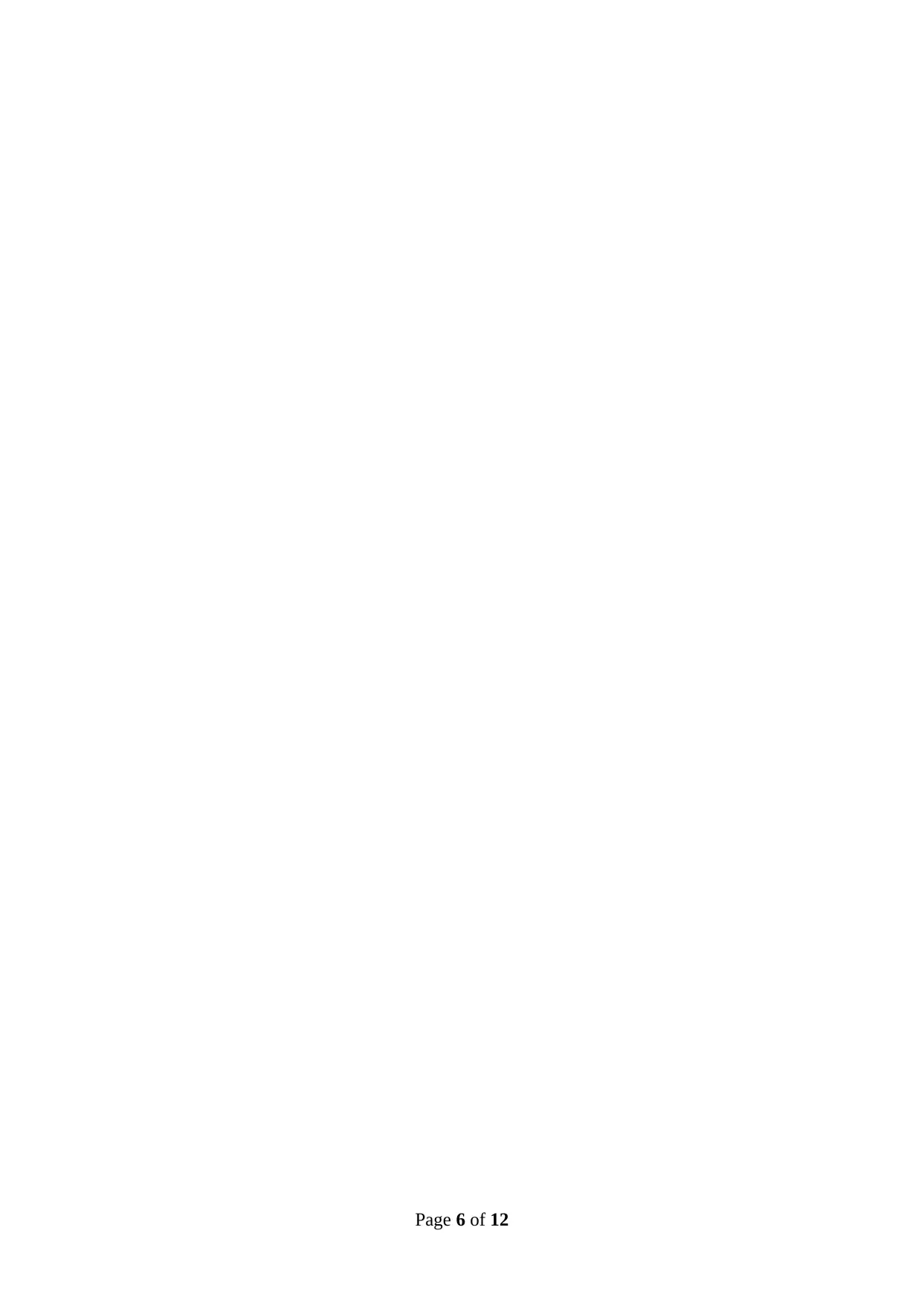
Page 6 of 12
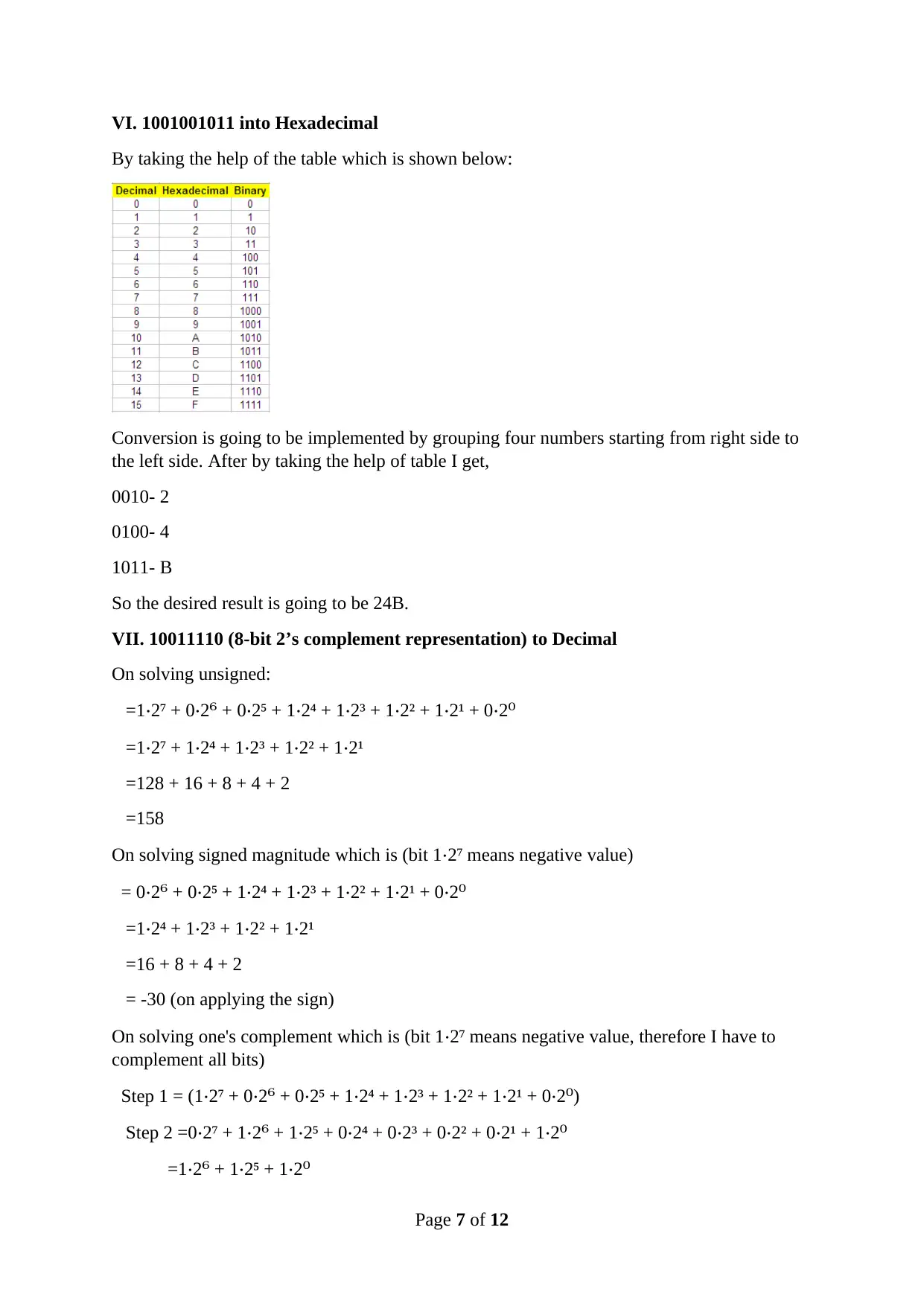
VI. 1001001011 into Hexadecimal
By taking the help of the table which is shown below:
Conversion is going to be implemented by grouping four numbers starting from right side to
the left side. After by taking the help of table I get,
0010- 2
0100- 4
1011- B
So the desired result is going to be 24B.
VII. 10011110 (8-bit 2’s complement representation) to Decimal
On solving unsigned:
=1⋅2⁷ + 0⋅2 + 0⁶ ⋅2⁵ + 1⋅2⁴ + 1⋅2³ + 1⋅2² + 1⋅2¹ + 0⋅2⁰
=1⋅2⁷ + 1⋅2⁴ + 1⋅2³ + 1⋅2² + 1⋅2¹
=128 + 16 + 8 + 4 + 2
=158
On solving signed magnitude which is (bit 1⋅2⁷ means negative value)
= 0⋅2 + 0⁶ ⋅2⁵ + 1⋅2⁴ + 1⋅2³ + 1⋅2² + 1⋅2¹ + 0⋅2⁰
=1⋅2⁴ + 1⋅2³ + 1⋅2² + 1⋅2¹
=16 + 8 + 4 + 2
= -30 (on applying the sign)
On solving one's complement which is (bit 1⋅2⁷ means negative value, therefore I have to
complement all bits)
Step 1 = (1⋅2⁷ + 0⋅2 + 0⁶ ⋅2⁵ + 1⋅2⁴ + 1⋅2³ + 1⋅2² + 1⋅2¹ + 0⋅2 )⁰
Step 2 =0⋅2⁷ + 1⋅2 + 1⁶ ⋅2⁵ + 0⋅2⁴ + 0⋅2³ + 0⋅2² + 0⋅2¹ + 1⋅2⁰
=1⋅2 + 1⁶ ⋅2⁵ + 1⋅2⁰
Page 7 of 12
By taking the help of the table which is shown below:
Conversion is going to be implemented by grouping four numbers starting from right side to
the left side. After by taking the help of table I get,
0010- 2
0100- 4
1011- B
So the desired result is going to be 24B.
VII. 10011110 (8-bit 2’s complement representation) to Decimal
On solving unsigned:
=1⋅2⁷ + 0⋅2 + 0⁶ ⋅2⁵ + 1⋅2⁴ + 1⋅2³ + 1⋅2² + 1⋅2¹ + 0⋅2⁰
=1⋅2⁷ + 1⋅2⁴ + 1⋅2³ + 1⋅2² + 1⋅2¹
=128 + 16 + 8 + 4 + 2
=158
On solving signed magnitude which is (bit 1⋅2⁷ means negative value)
= 0⋅2 + 0⁶ ⋅2⁵ + 1⋅2⁴ + 1⋅2³ + 1⋅2² + 1⋅2¹ + 0⋅2⁰
=1⋅2⁴ + 1⋅2³ + 1⋅2² + 1⋅2¹
=16 + 8 + 4 + 2
= -30 (on applying the sign)
On solving one's complement which is (bit 1⋅2⁷ means negative value, therefore I have to
complement all bits)
Step 1 = (1⋅2⁷ + 0⋅2 + 0⁶ ⋅2⁵ + 1⋅2⁴ + 1⋅2³ + 1⋅2² + 1⋅2¹ + 0⋅2 )⁰
Step 2 =0⋅2⁷ + 1⋅2 + 1⁶ ⋅2⁵ + 0⋅2⁴ + 0⋅2³ + 0⋅2² + 0⋅2¹ + 1⋅2⁰
=1⋅2 + 1⁶ ⋅2⁵ + 1⋅2⁰
Page 7 of 12
Paraphrase This Document
Need a fresh take? Get an instant paraphrase of this document with our AI Paraphraser
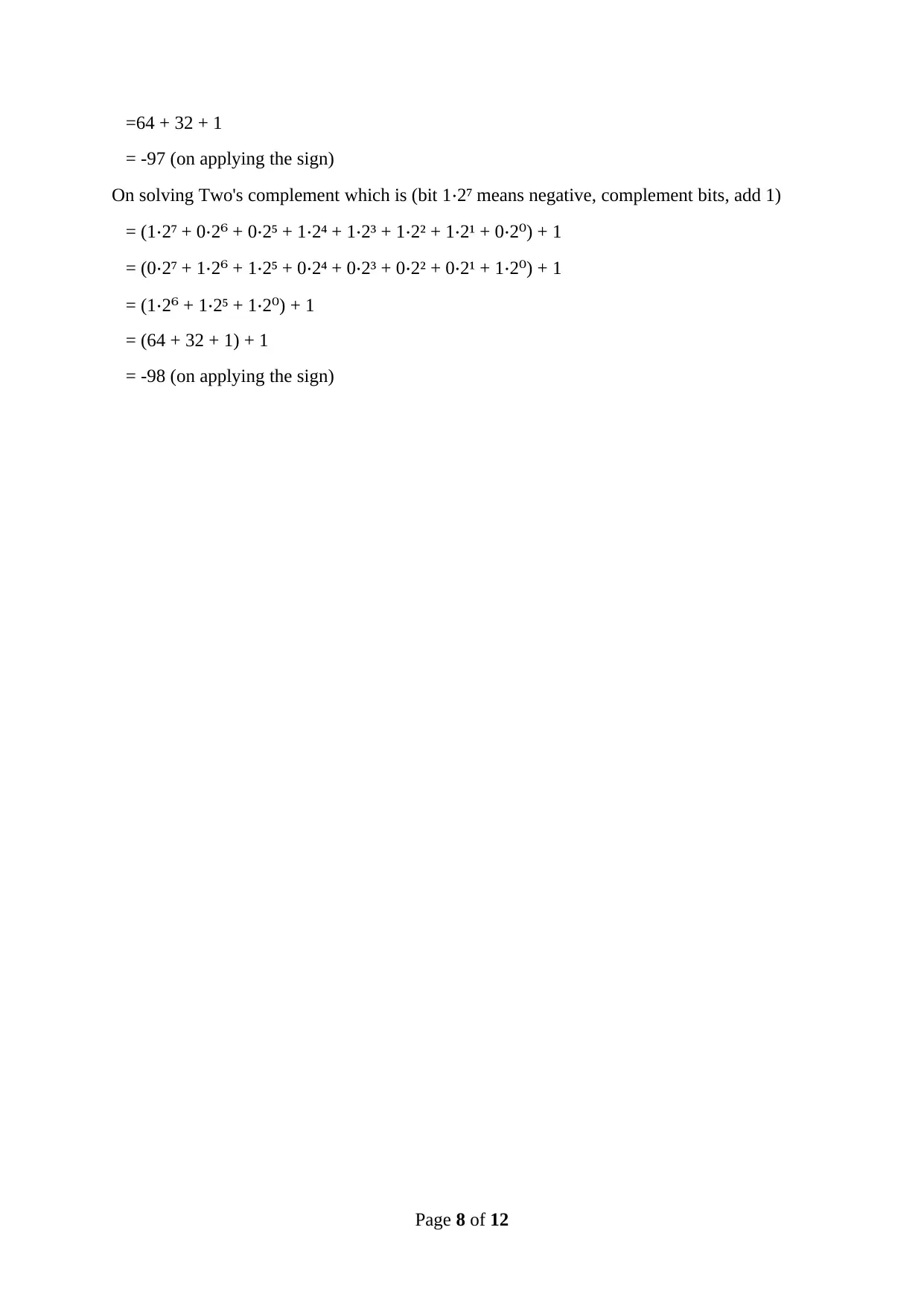
=64 + 32 + 1
= -97 (on applying the sign)
On solving Two's complement which is (bit 1⋅2⁷ means negative, complement bits, add 1)
= (1⋅2⁷ + 0⋅2 + 0⁶ ⋅2⁵ + 1⋅2⁴ + 1⋅2³ + 1⋅2² + 1⋅2¹ + 0⋅2 ) + 1⁰
= (0⋅2⁷ + 1⋅2 + 1⁶ ⋅2⁵ + 0⋅2⁴ + 0⋅2³ + 0⋅2² + 0⋅2¹ + 1⋅2 ) + 1⁰
= (1⋅2 + 1⁶ ⋅2⁵ + 1⋅2 ) + 1⁰
= (64 + 32 + 1) + 1
= -98 (on applying the sign)
Page 8 of 12
= -97 (on applying the sign)
On solving Two's complement which is (bit 1⋅2⁷ means negative, complement bits, add 1)
= (1⋅2⁷ + 0⋅2 + 0⁶ ⋅2⁵ + 1⋅2⁴ + 1⋅2³ + 1⋅2² + 1⋅2¹ + 0⋅2 ) + 1⁰
= (0⋅2⁷ + 1⋅2 + 1⁶ ⋅2⁵ + 0⋅2⁴ + 0⋅2³ + 0⋅2² + 0⋅2¹ + 1⋅2 ) + 1⁰
= (1⋅2 + 1⁶ ⋅2⁵ + 1⋅2 ) + 1⁰
= (64 + 32 + 1) + 1
= -98 (on applying the sign)
Page 8 of 12
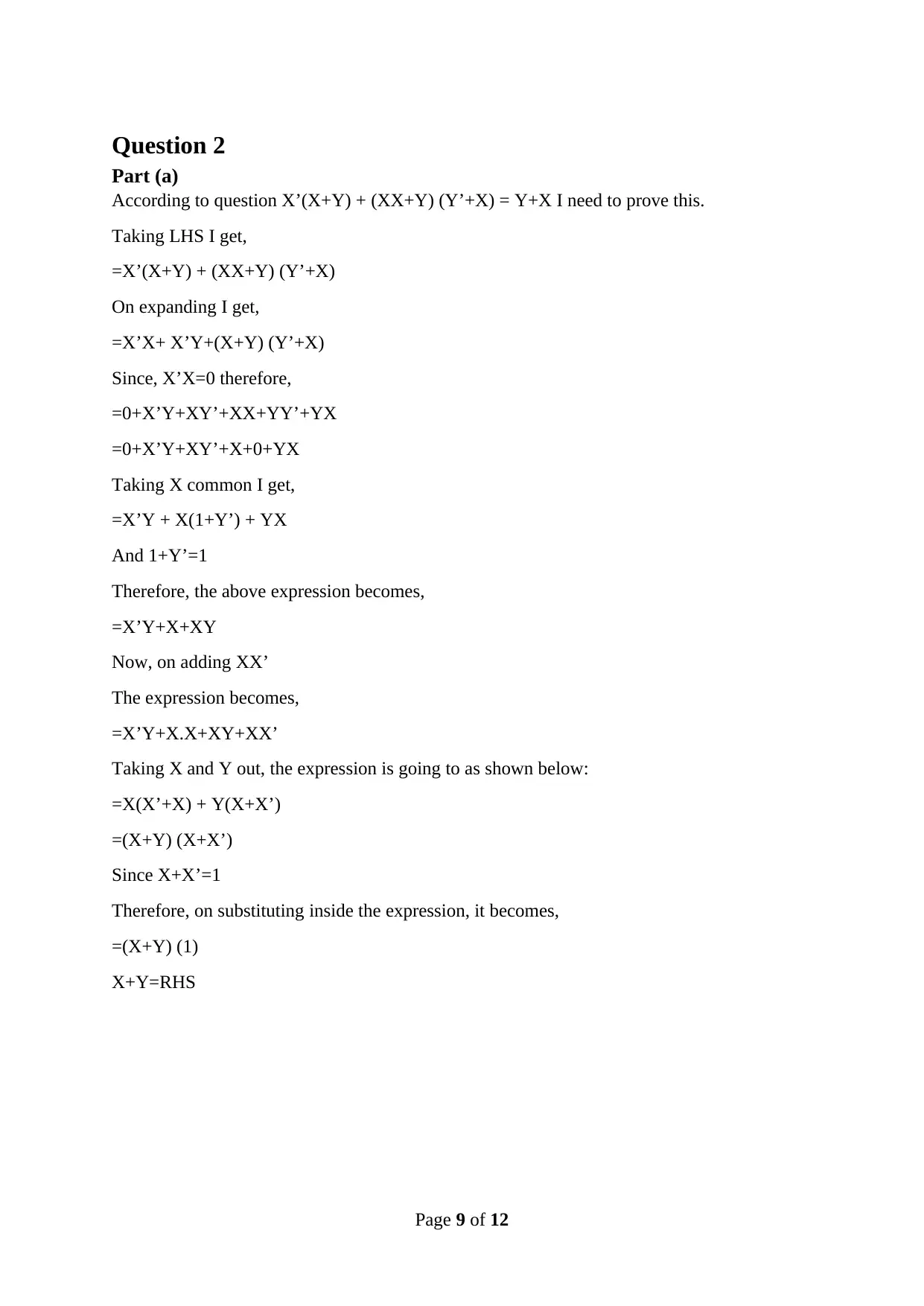
Question 2
Part (a)
According to question X’(X+Y) + (XX+Y) (Y’+X) = Y+X I need to prove this.
Taking LHS I get,
=X’(X+Y) + (XX+Y) (Y’+X)
On expanding I get,
=X’X+ X’Y+(X+Y) (Y’+X)
Since, X’X=0 therefore,
=0+X’Y+XY’+XX+YY’+YX
=0+X’Y+XY’+X+0+YX
Taking X common I get,
=X’Y + X(1+Y’) + YX
And 1+Y’=1
Therefore, the above expression becomes,
=X’Y+X+XY
Now, on adding XX’
The expression becomes,
=X’Y+X.X+XY+XX’
Taking X and Y out, the expression is going to as shown below:
=X(X’+X) + Y(X+X’)
=(X+Y) (X+X’)
Since X+X’=1
Therefore, on substituting inside the expression, it becomes,
=(X+Y) (1)
X+Y=RHS
Page 9 of 12
Part (a)
According to question X’(X+Y) + (XX+Y) (Y’+X) = Y+X I need to prove this.
Taking LHS I get,
=X’(X+Y) + (XX+Y) (Y’+X)
On expanding I get,
=X’X+ X’Y+(X+Y) (Y’+X)
Since, X’X=0 therefore,
=0+X’Y+XY’+XX+YY’+YX
=0+X’Y+XY’+X+0+YX
Taking X common I get,
=X’Y + X(1+Y’) + YX
And 1+Y’=1
Therefore, the above expression becomes,
=X’Y+X+XY
Now, on adding XX’
The expression becomes,
=X’Y+X.X+XY+XX’
Taking X and Y out, the expression is going to as shown below:
=X(X’+X) + Y(X+X’)
=(X+Y) (X+X’)
Since X+X’=1
Therefore, on substituting inside the expression, it becomes,
=(X+Y) (1)
X+Y=RHS
Page 9 of 12
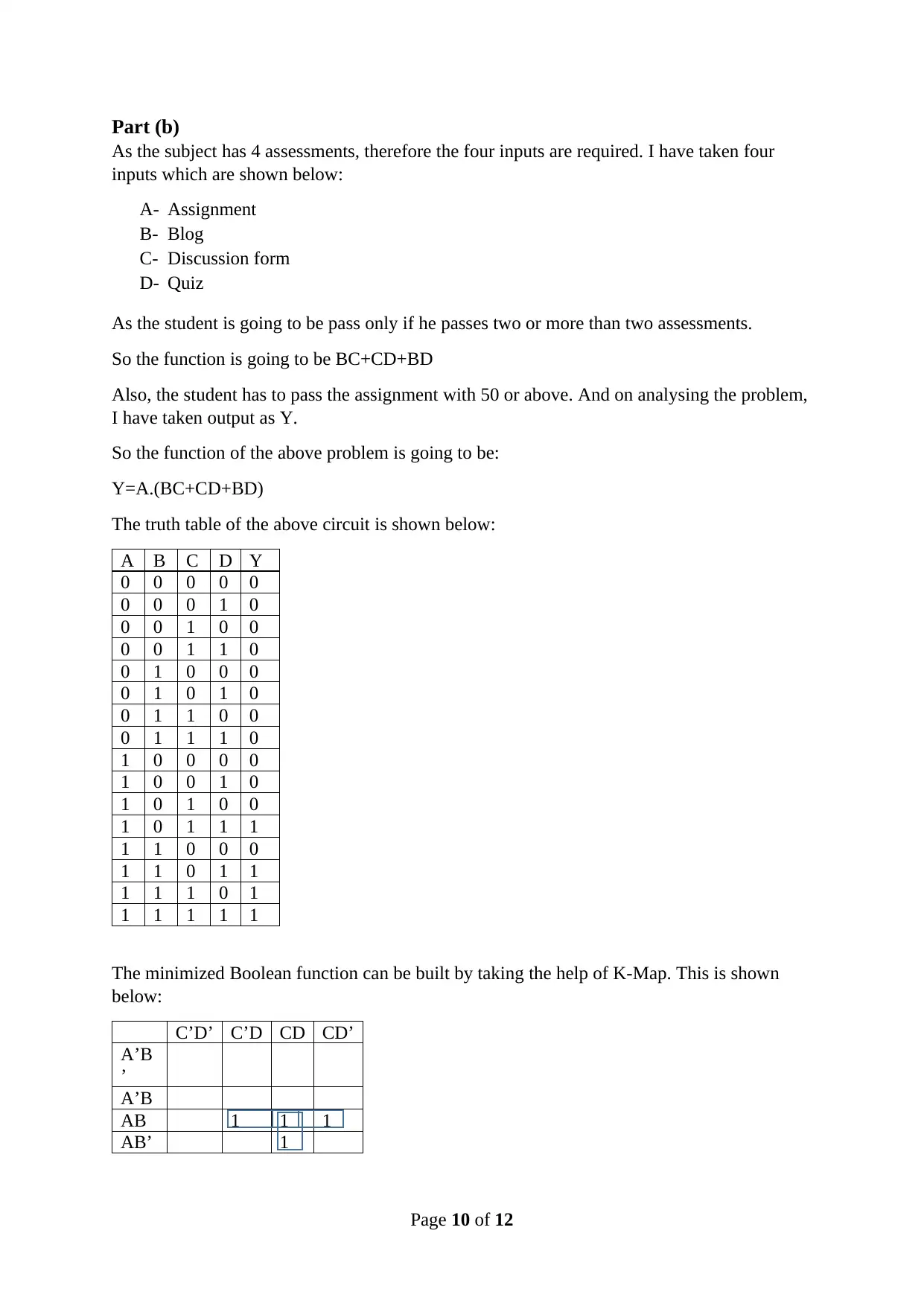
Part (b)
As the subject has 4 assessments, therefore the four inputs are required. I have taken four
inputs which are shown below:
A- Assignment
B- Blog
C- Discussion form
D- Quiz
As the student is going to be pass only if he passes two or more than two assessments.
So the function is going to be BC+CD+BD
Also, the student has to pass the assignment with 50 or above. And on analysing the problem,
I have taken output as Y.
So the function of the above problem is going to be:
Y=A.(BC+CD+BD)
The truth table of the above circuit is shown below:
A B C D Y
0 0 0 0 0
0 0 0 1 0
0 0 1 0 0
0 0 1 1 0
0 1 0 0 0
0 1 0 1 0
0 1 1 0 0
0 1 1 1 0
1 0 0 0 0
1 0 0 1 0
1 0 1 0 0
1 0 1 1 1
1 1 0 0 0
1 1 0 1 1
1 1 1 0 1
1 1 1 1 1
The minimized Boolean function can be built by taking the help of K-Map. This is shown
below:
C’D’ C’D CD CD’
A’B
’
A’B
AB 1 1 1
AB’ 1
Page 10 of 12
As the subject has 4 assessments, therefore the four inputs are required. I have taken four
inputs which are shown below:
A- Assignment
B- Blog
C- Discussion form
D- Quiz
As the student is going to be pass only if he passes two or more than two assessments.
So the function is going to be BC+CD+BD
Also, the student has to pass the assignment with 50 or above. And on analysing the problem,
I have taken output as Y.
So the function of the above problem is going to be:
Y=A.(BC+CD+BD)
The truth table of the above circuit is shown below:
A B C D Y
0 0 0 0 0
0 0 0 1 0
0 0 1 0 0
0 0 1 1 0
0 1 0 0 0
0 1 0 1 0
0 1 1 0 0
0 1 1 1 0
1 0 0 0 0
1 0 0 1 0
1 0 1 0 0
1 0 1 1 1
1 1 0 0 0
1 1 0 1 1
1 1 1 0 1
1 1 1 1 1
The minimized Boolean function can be built by taking the help of K-Map. This is shown
below:
C’D’ C’D CD CD’
A’B
’
A’B
AB 1 1 1
AB’ 1
Page 10 of 12
Secure Best Marks with AI Grader
Need help grading? Try our AI Grader for instant feedback on your assignments.
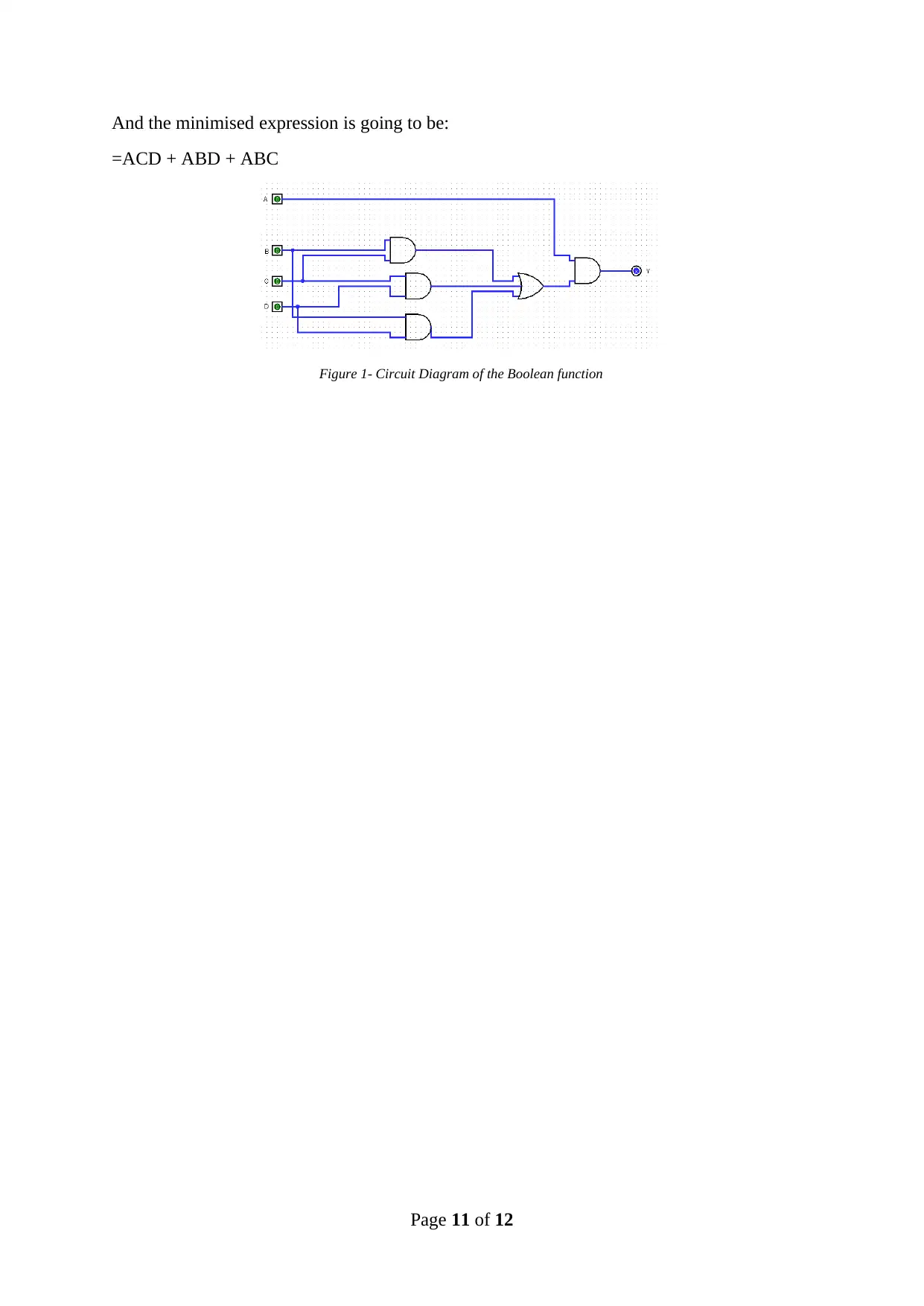
And the minimised expression is going to be:
=ACD + ABD + ABC
Figure 1- Circuit Diagram of the Boolean function
Page 11 of 12
=ACD + ABD + ABC
Figure 1- Circuit Diagram of the Boolean function
Page 11 of 12
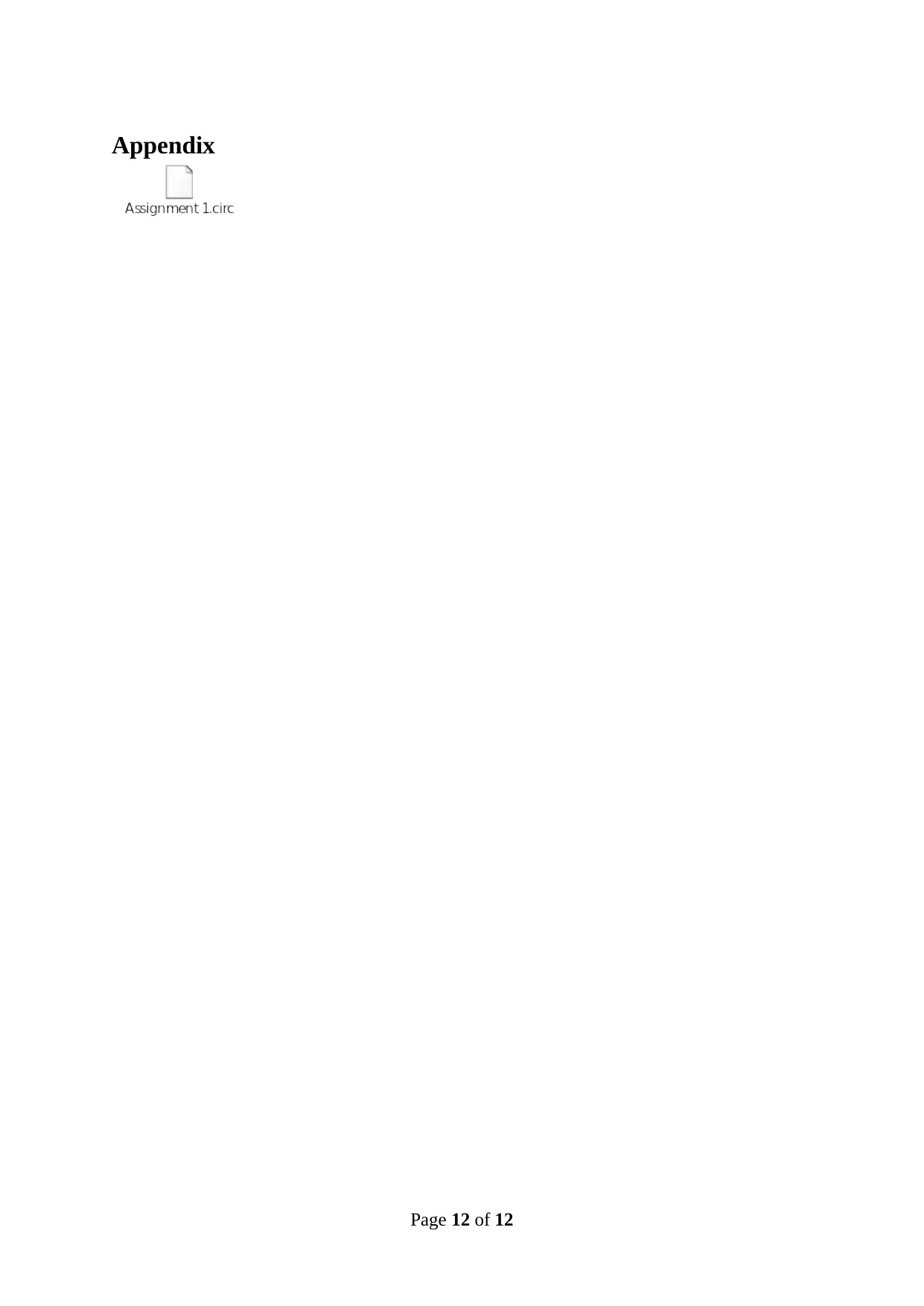
Appendix
Page 12 of 12
Page 12 of 12
1 out of 12
Related Documents
Your All-in-One AI-Powered Toolkit for Academic Success.
+13062052269
info@desklib.com
Available 24*7 on WhatsApp / Email
![[object Object]](/_next/static/media/star-bottom.7253800d.svg)
Unlock your academic potential
© 2024 | Zucol Services PVT LTD | All rights reserved.





